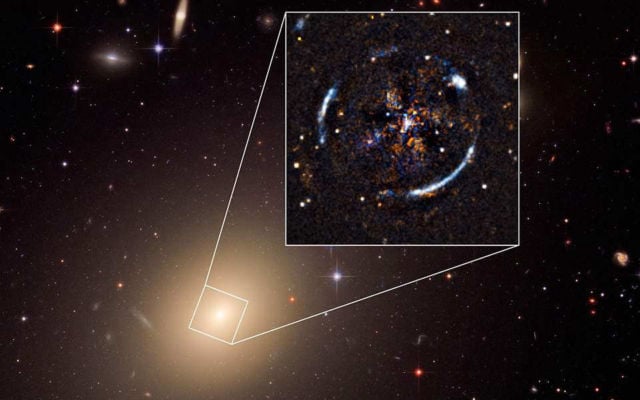Astronomers have made the most precise test ever of general relativity outside the Milky Way.
A nearby galaxy acts as a strong gravitational lens, distorting light from a distant galaxy behind it to create an Einstein ring around its center.
By comparing the mass of the lensing galaxy with the curvature of space around it, the astronomers found that gravity on these astronomical length-scales behaves as predicted by general relativity.
Above, an image of the nearby galaxy ESO 325-G004, created using data collected by the NASA/ESA Hubble Space Telescope and the MUSE instrument on the VLT. The inset shows the Einstein ring resulting from the distortion of light from a more distant source by intervening lens ESO 325-004, which becomes visible after subtraction of the foreground lens light. Image credit ESO, ESA/Hubble, NASA
Using data from the Hubble Space Telescope and the Very Large Telescope of the European Southern Observatory in Chile, scientists have shown that gravity actually behaves just as the general theory of relativity that Albert Einstein had shown in 1915.
Using the MUSE instrument on ESO’s VLT, a team led by Thomas Collett from the University of Portsmouth in the UK first calculated the mass of ESO 325-G004 by measuring the movement of stars within this nearby elliptical galaxy.
Interview with Thomas Collett about the research:
Collett explains: “We used data from the Very Large Telescope in Chile to measure how fast the stars were moving in ESO 325-G004 — this allowed us to infer how much mass there must be in the galaxy to hold these stars in orbit.”
But the team was also able to measure another aspect of gravity. Using the NASA/ESA Hubble Space Telescope, they observed an Einstein ring resulting from light from a distant galaxy being distorted by the intervening ESO 325-G004. Observing the ring allowed the astronomers to measure how light, and therefore spacetime, is being distorted by the huge mass of ESO 325-G004.
source ESO






Leave A Comment